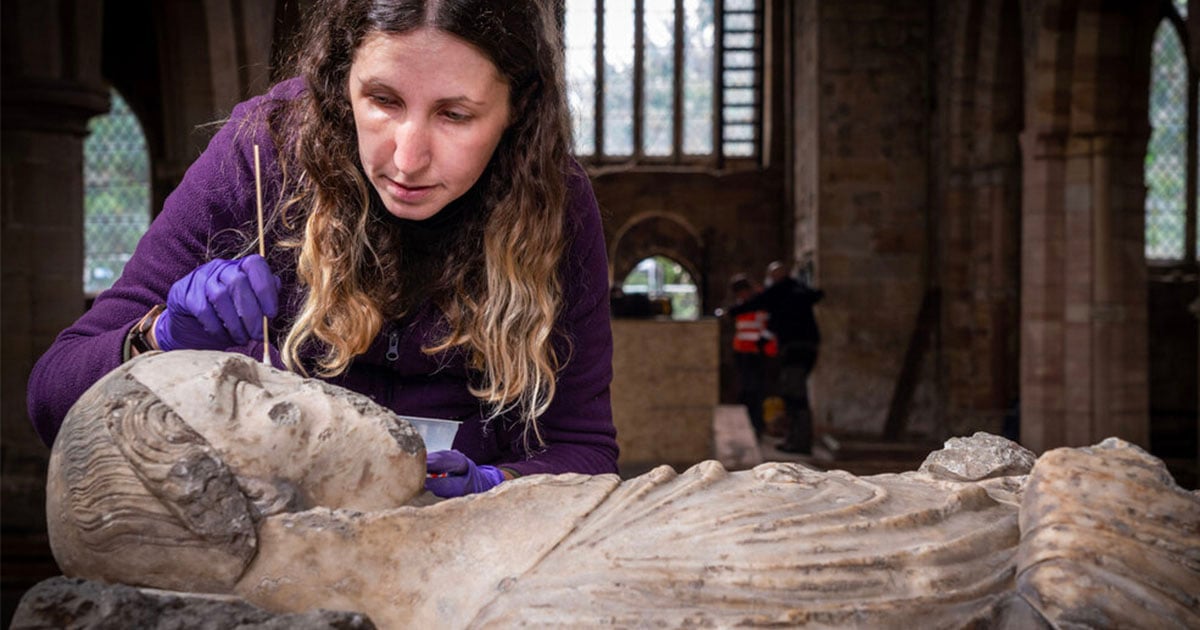A mystery alabaster statue has been discovered during the renovation of a medieval English village church. The stone holy man was discovered during the restoration of England’s 10th century, Anglo Saxon, St. Wilfrid’s Church, in Barrow upon Trent in Derbyshire. The St. Wilfrid’s Church effigy represents the “earliest alabaster effigy of a priest ever discovered.” Dating back to around 1348 AD, the stone man is thought to be John de Belton, a legendary local priest who is known to have died while protecting parishioners from the Black Death

Church warden Anne Heathcote stated in a press release that the discovery was made when a pipe organ was removed, and that “few people even knew the effigy existed.” Conservators have confirmed the monument has “more medieval paint than any other effigy from the era,” including azurite, red, green and black, and significant levels of pure gold were also found. Heathcote explains that this rare discovery is exciting and “beyond our expectations.”

Encasing the Holy Man in GlassThe church restoration project cost in excess of £800,000 ($1,080,000) and it was undertaken after the National Lottery topped up the church funds with a £563,000 ($760,000) grant. The church warden said that while you can see the sculptor’s “beauty and skill” reflected in the tonne-and-a-half priest’s gown, his face is badly damaged. Researchers think most probably occurred during the English Reformation in the 16th-century, when the Church of England broke away from the authority of the Pope and the Roman Catholic Church.

Heathcote said the mystery St. Wilfrid’s Church effigy would originally have been “very ornate and covered in bling.” The priest’s head is cradled in an angel’s hands and a dog is nestled at his feet, and while it’s believed to be John de Belton, Heathcote says “it’s hard to know who the effigy represents.” The monument has now been restored and will be encased in protective glass with a mirror positioned behind it, so that visitors will be able to see both sides of the intricately carved monument.

The Oldest Alabaster Priest in EnglandThe Anglo Saxon St Wilfred’s Church is a pre conquest Anglo Saxon building that was given to the Knights Hospitaller in 1165 AD by Robert de Bakepuiz, and these crusading warriors developed the building until around 1540 AD. The Guardian says that after the Reformation the effigy was hidden behind box pews and that it was moved behind a pipe organ the 18th century. Heathcote is one of the few people who ever knew of its existence and she says she has known it was there since she was three or four years old.

In an article in the BBC, Dr. David Carrington, who runs a conservation firm, says priest John de Belton died around 1350 AD, and that the sculpture was “one of the earliest such alabaster effigies.” While these statues became more common later in the 14th Century, there are only six or seven of this age, “so this was something of a trendsetter,” Carrington said. This is confirmed by Sally Badham in her 2016 book, The rise to poularity of alabaster for memorialisation in England , which says St. Wilfred’s Church is mentioned in the Domesday Book . The St. Wilfrid’s Church alabaster effigy of the priest believed to be John de Belton is the “the oldest existing alabaster effigy of a priest in the England.”
A Modern Space for Ancient RitualsThe medieval church has been repurposed several times since its origins in the 10th century. While it will still host baptisms, funerals and weddings, the entire building has been renovated into a modern open plan space. With underfloor heating and halo-shaped LED lights suspended from the ceiling, The Guardian report that the medieval holy place will also be used by community groups for exercise classes and meetings. Furthermore, no longer will congregations only gaze upon the ancient alter at St. Wilfrid’s Church, but a hi-tech music mixing desk and amplifier will accompany a large projector screen for screening films.
Top image: During a restoration project in a medieval English church, experts have brought to light the existence of the St. Wilfrid’s Church effigy, an alabaster statue said to be of a legendary local priest. Source: Penguin PR